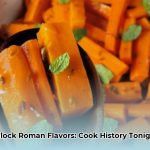Imagine stepping into the vibrant tapestry of ancient Rome, not amidst the grandeur of the Colosseum or the solemnity of the Forum, but into the bustling heart of its kitchens. Here, amidst the clatter of pottery and the scent of woodsmoke, delightful desserts were fashioned—far removed from the refined sugars and complex machinery of today. Roman culinary art celebrated the inherent sweetness of nature, relying heavily on honey, fruits, and nuts. This journey back in time offers a delicious glimpse into what citizens of all strata truly savored, from simple everyday treats to profound sacred offerings. Prepare to explore the rich history of Roman sweets, uncover their core ingredients, understand their societal role, and even learn how to recreate authentic iconic dishes like the ancient Roman cheesecake, Libum.
Discover more about Roman food recipes for inspiration.
The Palate of Plenty: Beyond Refined Sugar
In the heart of the Roman Empire, the concept of sweetness was intrinsically linked to its natural bounty. Without access to refined cane sugar, Roman cooks masterfully harnessed the sweetness found in their environment, creating a distinct and remarkably sophisticated flavor profile.
Honey: The Golden Standard
Honey was the undisputed king of sweeteners, a liquid gold that permeated nearly every sweet dish. Sourced from various regions across the vast empire, each type of honey offered its own unique floral notes and depth of flavor, depending on the local flora. This versatility allowed honey to infuse countless dishes, from simple cakes to elaborate pastries, providing a rich, natural sweetness that defined the Roman palate. Beyond honey, other natural sweeteners like grape must (a concentrated syrup made from freshly pressed grape juice) and dried dates were also extensively used, offering caramel-like sweetness and binding properties to many confections.
Fruits and Nuts: Nature’s Candy
Fresh and dried fruits were indispensable, offering both sweetness and intriguing textures to desserts. Figs, grapes, dates, pomegranates, and apples were not merely side dishes but primary ingredients, consumed raw, baked into pastries, or transformed into preserves. Nuts like almonds, walnuts, hazelnuts, and pistachios contributed a satisfying crunch and a rich, earthy depth of flavor. These natural components, often combined simply with honey, highlight a fundamental difference from modern dessert traditions centered on processed ingredients.
Creamy Bases and Savory Twists
Creamy cheeses, often a precursor to modern ricotta or fresh sheep’s cheese, provided a luxurious, tangy counterpoint to the sweetness of honey and fruit. These cheeses formed the base for many popular Roman “cheesecakes,” showcasing a balanced approach that often blended sweet and savory notes, a hallmark of Roman gastronomy. Unexpected ingredients, such as black pepper, cumin, anise, or even garum (a fermented fish sauce) in some dessert variations, demonstrate the Romans’ adventurous approach to flavor, creating complex and intriguing palates that challenge modern assumptions about sweet treats.
Simple Preparations, Rich Flavors
Roman dessert preparation often involved straightforward techniques, emphasizing the quality of ingredients rather than elaborate cooking methods. Baking, boiling, and simple mixing were common. Items like Libum were baked in simple ovens or even on hot stones, while grain-based desserts might be boiled. Many “recipes” were more descriptive guidelines than precise measurements, relying on the cook’s experience and intuition. This improvisational approach allowed for regional variations and personal creativity within established culinary traditions.
A Culinary Kaleidoscope: Iconic Roman Desserts
The culinary landscape of ancient Rome offered a diverse array of sweets, some of which held profound cultural or religious significance, while others were simple daily delights.
Libum: The Sacred Cheesecake
More than just a cheesecake, Libum was a sacred offering, often presented to the gods during religious ceremonies. Made with ricotta or sheep’s cheese, flour, and honey, its recipe offers a direct link to Roman ritualistic dining and community celebrations, particularly the Liberalia festival honoring Liber Pater. This connection between food and sacred practice reveals the deeper cultural role of Roman cuisine. Historically, its soft, spongy texture and subtle sweetness made it a widely appreciated treat, transcending its religious functions to be enjoyed by many.
Placenta: A Layered Masterpiece
Often compared to a layered pastry similar to baklava or a very rich cheesecake, Placenta featured multiple thin layers of dough filled with a mixture of soft cheese and honey. Its intricate, layered structure hints at sophisticated baking techniques prevalent in the era, typically baked until golden and crispy outside, with a soft, gooey interior. Cato the Elder, in his detailed recipe, specified wheat flour and alica (a form of spelt) for the dough layers, and sheep’s cheese for the filling. This elaborate dessert was a symbol of luxury and sophistication, frequently gracing banquets, weddings, and other significant social gatherings, reflecting the host’s prosperity.
Globi: Ancient Rome’s Doughnuts
These small, fried pastries, often drizzled generously with honey or dusted with poppy seeds, were the Roman equivalent of modern doughnuts—a popular street food enjoyed extensively by all social classes. Documented in ancient cookbooks like Apicius’s De Re Coquinaria, Globi were made from a simple dough of flour, water, and sometimes cheese or semolina, then fried until golden and crispy. Their portability and affordability made them easily accessible from street vendors, and they were also a common sight at festivals and celebrations, fostering a sense of shared culinary tradition.
Savillum: The Roman Cheesecake
Similar to Libum, Savillum represents another popular form of Roman cheesecake, made with a blend of fresh cheese, flour, eggs, and honey, often flavored with bay leaves or cinnamon. Baked to a rich, creamy consistency, it was enjoyed by various segments of Roman society, not exclusively the wealthy. Its simplicity and deliciousness likely contributed to its widespread appeal, potentially serving as a practical and nourishing option even for the Roman military, due to its presumed portability and shelf life.
Dulcia Domestica: Everyday Sweet Bites
Literally translating to “domestic sweets,” Dulcia Domestica were simple, yet satisfying combinations of dried fruits (like dates and figs) and nuts (almonds, walnuts), often bound together with honey. These bite-sized treats provided a quick energy boost and were widely popular among all social strata. Their ease of preparation and portability made them an ideal snack for daily consumption, or as sustenance for travelers and soldiers during long journeys.
Mustaceum: Wedding Wonders
Mustaceum held a special place in Roman society, primarily serving as a symbolic wedding cake. Made from flour, honey, and must (sweet grape juice), these rhombus-shaped cakes were often adorned with dried fruits. The sharing and breaking of Mustaceum by guests at weddings symbolized commitment and well wishes for the newlyweds’ sweet life, highlighting the dessert’s important cultural and ceremonial role.
Tyropatina & Scriblita: Other Notable Delights
Tyropatina was another custard or cheesecake-like dessert, made from soft cheese, eggs, honey, and milk, often seasoned with surprising elements like black pepper. Scriblita resembled a fritter or doughnut, made from a simple dough and fried, then drizzled with honey or spiced, popular as street food. These examples further illustrate the variety and ingenuity of Roman sweet treats.
Frozen Delights: The Roman “Ice Cream”
While the Romans did not have churned, creamy ice cream as we know it today, they enjoyed a form of frozen dessert called nivatae potiones (“snow drinks”). This involved mixing mountain snow or ice (collected and stored in underground pits) with wine, fruit, honey, and spices. This cool, sweet treat was a luxury primarily enjoyed by the wealthy elite, a refreshing indulgence during the hot Roman summers.
Dessert and Distinction: Social Class in Roman Cuisine
Just as societal structures dictated many aspects of Roman life, social class significantly influenced dessert consumption, creating a visible culinary divide.
| Feature | Wealthy Romans | Lower-Class Romans |
|---|---|---|
| Ingredients | Rare fruits (apricots, pomegranates), imported spices (saffron), refined grains, expensive honeys. | Locally sourced honey, common seasonal fruits (figs, grapes), basic nuts, readily available grains. |
| Preparation | Elaborate, requiring skilled chefs; intricate layering, molding, complex garnishing. | Straightforward methods; boiling, simple mixing, minimal baking. |
| Presentation | Visually stunning, often artistic creations; symbols of affluence and refined taste. | Simple, practical, and nutritious; served as functional treats. |
| Examples | Highly adorned Placenta, spiced Savillum, elaborate fruit platters with rare varieties. | Honeyed figs, dates stuffed with nuts, simple Globi. |
| Significance | Displayed wealth, cultural sophistication, central to lavish banquets and high-status gatherings. | Provided daily sustenance and energy; contributed to community festivals in more modest forms. |
This clear distinction in Roman desserts underscores the broader socio-economic dynamics of the period, where food was not only nourishment but also a powerful marker of status and identity.
The Enduring Legacy: Rome’s Sweet Influence Today
The culinary ingenuity of ancient Rome has left an indelible, though often subtle, mark on modern cuisine. While it is tempting to draw direct, linear connections between ancient Roman desserts and modern-day Italian sweets like cannoli, tiramisu, or ricotta cheesecake, the reality is more nuanced. The evolution of these desserts has been shaped by centuries of cultural exchange, regional innovations, and evolving culinary practices.
However, the Roman emphasis on natural sweeteners, fresh local ingredients, and specific techniques, like layered pastries or cheese-based desserts, undeniably laid foundational concepts. Many crostate (tarts) and certain ricotta-based pastries found in Italy today echo the spirit, if not the exact recipes, of ancient Roman sweets. The core principles of balancing flavors and utilizing natural resources, perfected by Roman cooks, continue to resonate in contemporary culinary arts worldwide.
Your Culinary Expedition: Engaging with Roman Desserts
Recreating these desserts offers a tangible connection to the past, enriching your understanding of Roman culture. This adaptive approach ensures that the ingenious flavors of an ancient empire continue to inspire new culinary creations. Here’s how you can engage:
- For the History Buff: Begin by attempting a simple dessert like Libum, utilizing readily available modern ingredients. Share your unique culinary experience and findings with friends to spark conversations about Roman history. In the long term, delve deeper by researching various Roman dessert recipes, comparing their historical contexts and exploring primary sources like Apicius: De Re Coquinaria. Consider a visit to a museum showcasing ancient Roman culinary artifacts to enrich your understanding.
- For the Foodie: Incorporate elements of ancient Roman flavors into your contemporary cooking, perhaps by experimenting with honey glazes or fruit and nut combinations in your accustomed dishes. As a more ambitious endeavor, host a Roman-themed dinner party, complete with historically inspired desserts like Placenta. This offers an immersive experience, allowing for creative exploration in decorations and attire.
- For the Food Blogger/Enthusiast: Craft engaging content, such as a video or a blog post, by meticulously recreating Dulcia Domestica. Share your culinary journey online, discussing the fascinating historical background of the recipe and the challenges of historical food recreation. For a sustained engagement, consider initiating a cooking club focused on ancient Roman food, where participants can collectively attempt challenging recipes and compare their versions. This collaborative effort has a high engagement potential among niche audiences. You could even explore how modern ingredients like gelatin relate to ancient consistency techniques.
Recipes: Bringing History to Your Table
Embarking on the creation of ancient Roman desserts often involves a degree of interpretation. While specific Roman ingredients like certain grape varietals or unique cheeses might be scarce today, the essence of these recipes can be captured using modern substitutions. The objective is to evoke the historical flavor profile, rather than achieve an exact, unattainable replication. Did you know that Roman cooks rarely used precise measurements, leading to much culinary improvisation, a spirit you can embrace in your own kitchen?
Recipe 1: Libum (Ancient Roman Cheesecake)
Historical Context: Libum transcends mere dessert; it signified a sacred offering, frequently presented to the gods during religious ceremonies. While the exact priestly recipe remains elusive, this adapted version aims to capture its core flavor and simplicity authentically, embodying its dual role as both a ritualistic item and a delightful treat.
Ingredients:
- 1 cup all-purpose flour
- 1 cup fresh ricotta cheese (a readily available modern substitute for traditional sheep’s cheese)
- 1/2 cup honey, plus extra for drizzling
- 1 large egg
- Pinch of fine sea salt
- Optional: 1-2 bay leaves for aroma (placed on top during baking, removed before serving)
Instructions:
- Preparation: Preheat your oven to 350°F (175°C). Lightly grease a small baking sheet or line it with parchment paper.
- Combine Ingredients: In a medium-sized mixing bowl, thoroughly combine the measured flour, ricotta cheese, honey, egg, and salt. Mix using a wooden spoon or spatula until the batter achieves a smooth, consistent, and well-blended texture. Ensure there are no dry pockets of flour.
- Form: Gently shape the prepared mixture into a flat, round cake, approximately 1 inch thick and about 5-6 inches in diameter. For a more rustic appearance, you can form smaller individual cakes. If using, place a bay leaf or two on top of the cake.
- Bake: Carefully place the formed cake(s) onto the prepared baking sheet. Bake for approximately 40-45 minutes, or until its surface turns a deep golden brown and a toothpick inserted into the center comes out clean. The top should feel firm to the touch.
- Serve: Allow the Libum to cool completely on a wire rack before attempting to slice it. Remove the bay leaves if used. Once cooled, slice and serve.
Tips & Variations:
- For an expedited preparation, consider using a pre-made shortcrust pastry as an alternative base to forming the dough from scratch, though this deviates slightly from the historical method.
















